This post may contain affiliate links. Please see our disclosure policy.
Gooseberry jam is one of those old-fashioned preserves that deserves a comeback. Its bright, tart flavor and natural pectin content make it incredibly easy to work with, and the result is a firm-set jam that’s both bold and refreshing. Whether you’re using green, red, or blush-colored gooseberries, this jam captures the unique character of the fruit in every spoonful.
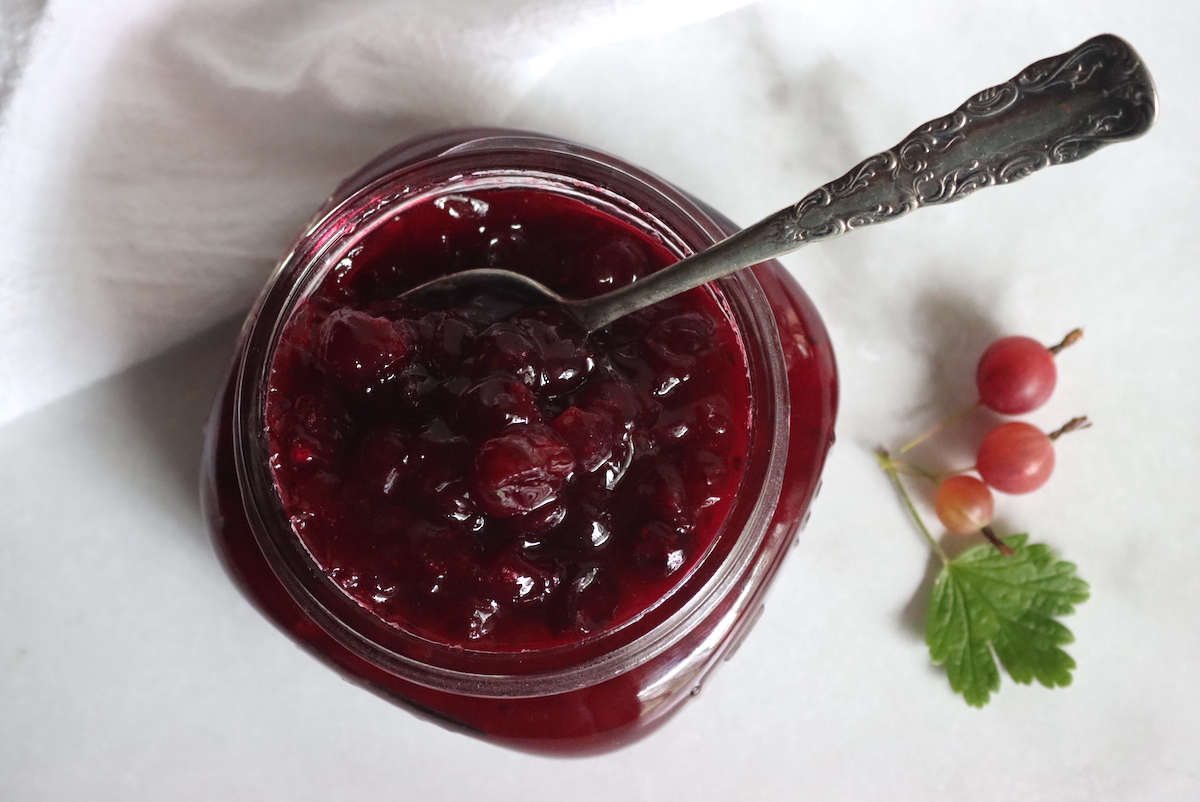
Gooseberries might be an old-fashioned fruit, but they make some of the best jam you’ll ever taste. Whether you’re working with green, red, or pink varieties, gooseberry jam has a bright, tart flavor and a natural tang that sets it apart from more common preserves. Thanks to their high pectin content, gooseberries set easily without added pectin—making them perfect for small-batch jams with big flavor.
This old fashioned preserve isn’t just a jammy spread for many people – it’s a nostalgic experience that brings back memories of grandma’s kitchen and simpler times.
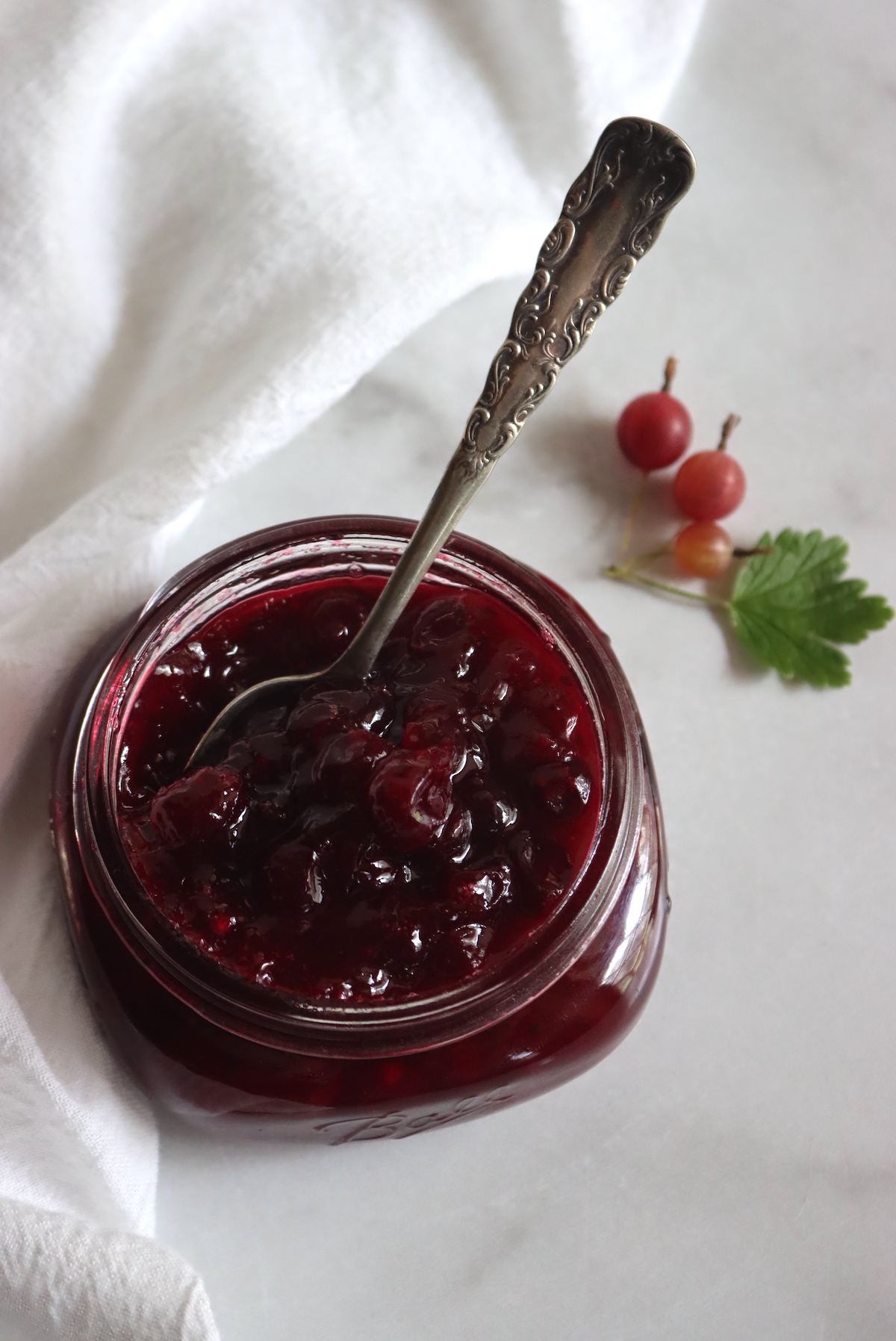
A Quick Look at the Recipe
- Recipe Name: Gooseberry Jam
- Recipe Type: Jam Recipe Without Pectin
- Canning Method: Waterbath Canning or Steam Canning
- Prep/Cook Time: 50 Minutes
- Canning Time: 10 Minutes
- Yield: 3 half pint jars
- Jar Sizes: Quarter Pint, Half Pint or Pint
- Headspace: 1/4 inch
- Ingredients Overview: Gooseberries, Lemon Juice (optional) and sugar
- Difficulty: Moderate. Familiarize yourself with how to check for set in jam recipes without added pectin before you begin.
- Similar Recipes: The process is very similar to making other old fashioned jams without added pectin, including summer recipes like Sour Cherry Jam, Blueberry Jam, Strawberry Jam, Blackberry Jam, and Grape Jam.
Ingredients for Gooseberry Jam
The ingredients for canning gooseberry jam are quite simple. To make a small batch of 3 half pint jars, you’ll need the following:
- 1 lb gooseberries (roughly three cups)
- ¼ cup water
- 2 cups sugar (1 lb)
- 1-2 Tbsp lemon juice (optional)
You can use any variety of gooseberries, but red gooseberries are some of the best for jam. They give the jam a beautiful deep red color and a rich flavor that’s a bit more complex than the green variety.

Many recipes for gooseberry jam have you pick about 1/3 underripe fruit to increase the pectin content. That’s not strictly required, as even fully ripe gooseberries are really high in pectin. They’re so high pectin, in fact, that it’s a bit tricky to make gooseberry wine because the fruit actually set during fermentation sometimes (even without cooking).
If you do have fruit that’s a bit green, it’ll ripen sitting on the counter in a few days to a week. Leave it a bit green, or let it ripen before you make the jam, it’s up to you.
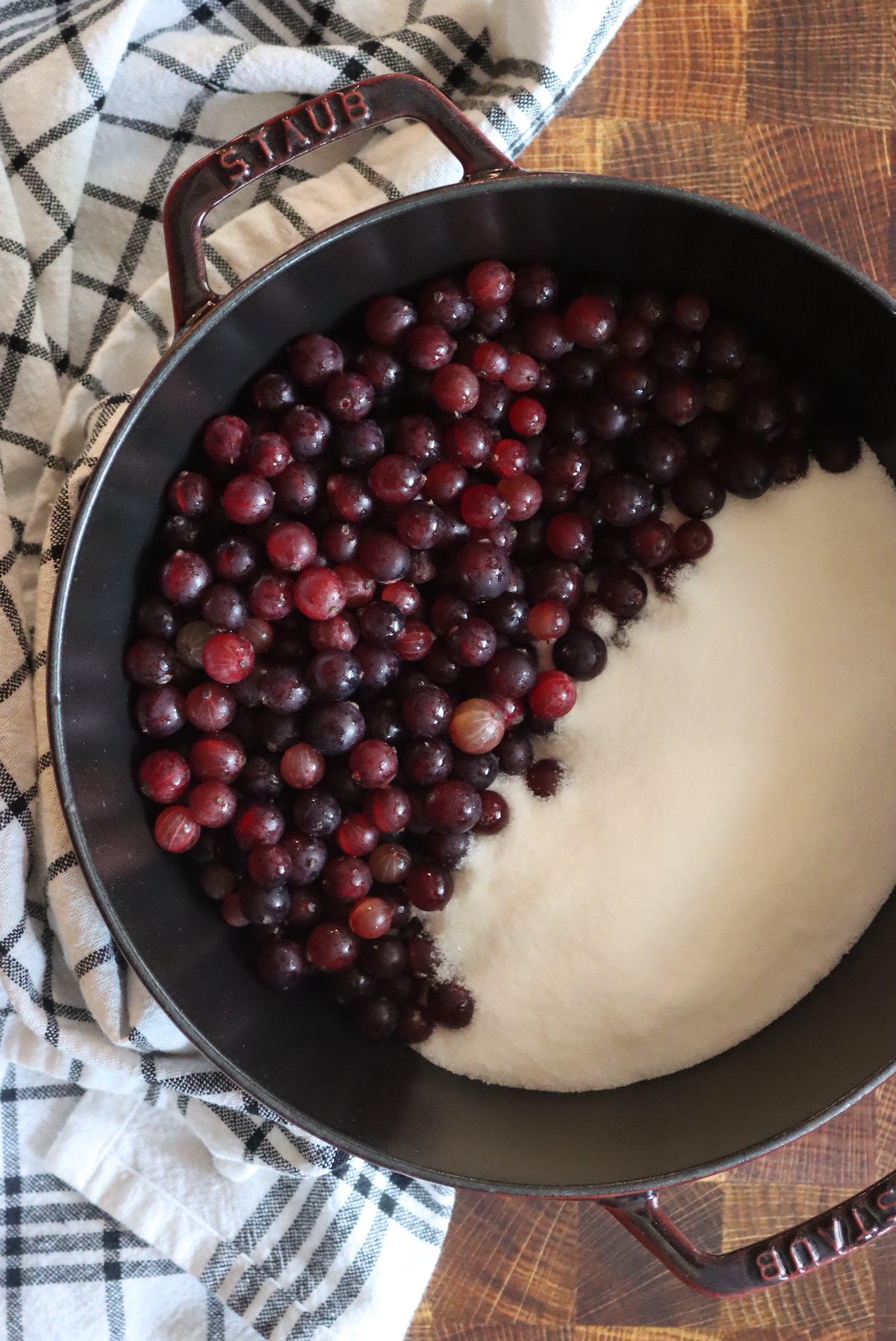
Gooseberry Jam Variations
Simple gooseberry jam can be infused with other flavors for a unique twist, and in the UK, Gooseberry Gin Jam and Elderflower Gooseberry Jam are popular variations. For the Gin version, all you need to do is all ¼ cup of gin as this jam starts to thicken. For the elderflower version, you add ¼ cup of elderflower cordial.
It also pairs well with rhubarb, and since gooseberries have lots of pectin, they help set low pectin rhubarb. You can add up to 2 cups chopped rhubarb to this recipe, along with an extra ½ cup of sugar, and it’ll still set nicely.
How to Make Gooseberry Jam
Before you start cooking, you need to prepare the gooseberries. This involves cleaning and removing the tops and tails. It might be a bit time-consuming, but it’s worth it. You need to do this for other gooseberry canning recipes, including canning whole gooseberries and canning gooseberry pie filling.
(If you want to skip this step, consider making gooseberry jelly or gooseberry juice instead, since all the solids are filtered out so you don’t have to top and tail the fruit.)
Simply take a small paring knife and trim off any remaining stem and the blossom of the fruit. You can do it with your finger nails too, whatever works for you.
You’ll end up with quite a pile of tops, tails and leafy/stemmy debris from a bowl of gooseberries. All that would have been in your jam if you hadn’t cleaned the batch!

Place the cleaned gooseberries into a pot with a bit of water and a splash of lemon juice (if using). The lemon juice isn’t necessary for canning, but it does enhance the flavor. Cook on medium-high heat, stirring often until the berries disintegrate, which should take about five minutes.
Next, you need to add your sugar. Gooseberries are naturally tart, so don’t skimp here. You can play around with the numbers a little bit to get the balance and desired sweetness right, but most recipes call for ¾ to 1 pound of sugar per pound of fruit. That’s about 1 ½ to 2 cups of sugar for three cups of gooseberries.
Add the sugar to the pot and bring it to a rapid boil. Cook for another 8 to 10 minutes until the mixture reaches the gel stage. You can test for the gel stage with a kitchen thermometer (220 degrees F) or the plate method. Place a plate in the freezer and test a small spoonful of jam on the cold plate. If it gels, your jam is ready.
Alternatively, you can dip a spoon into the pot and pour it back in. If the jam begins to “sheet” off the spoon rather than drip, it’s done.
Experienced jam makers will notice how the color and sheen of the bubbles changes when the jam reaches set point, and the bubbles will be large and glossy instead of foamy (see below, at right, the jam has just reached gel stage).
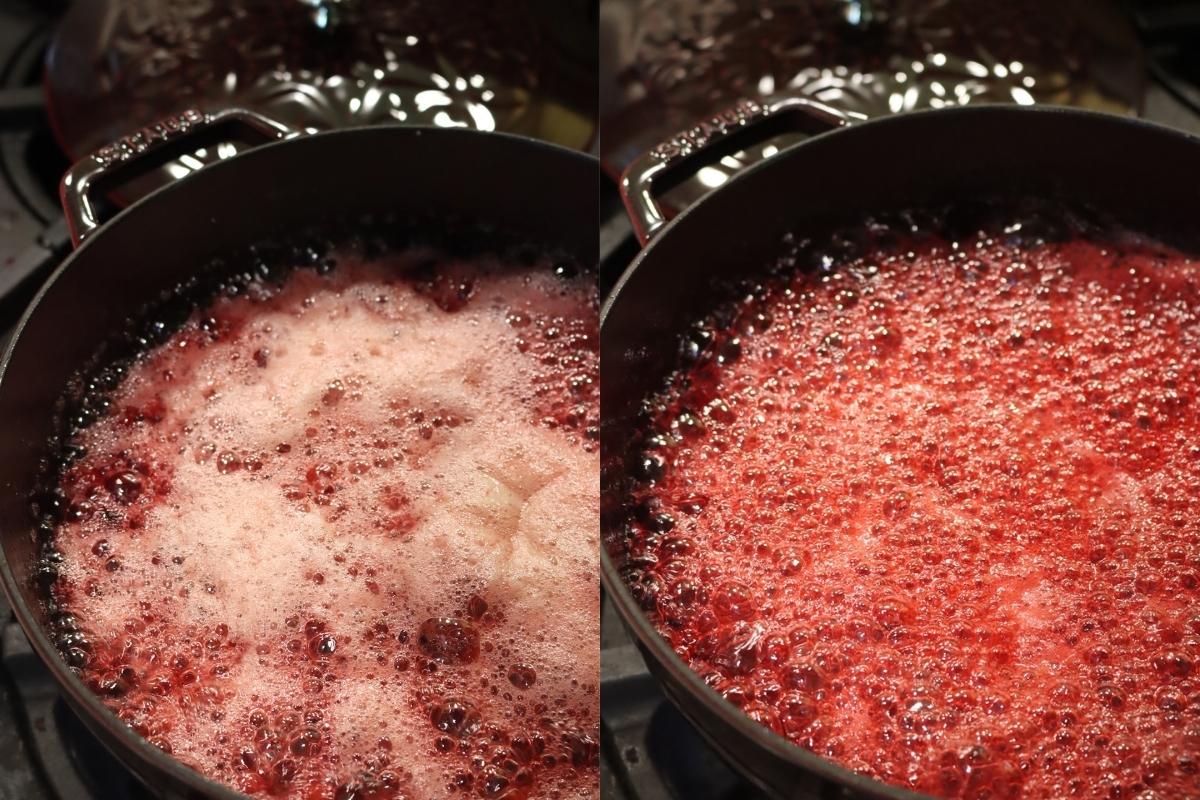
Canning Gooseberry Jam
Pour the finished jam into prepared jars, leaving ¼ inch headspace. The jam will keep in the fridge for weeks, or you can process the jars in a water bath canner for 10 minutes (or 15 minutes above 6,000 feet in elevation) to make it shelf-stable for years.
Once canned, store your gooseberry jam in a cool, dark place. Properly sealed jars can last up to a year. Once opened, keep the jar in the refrigerator and consume within a few weeks.
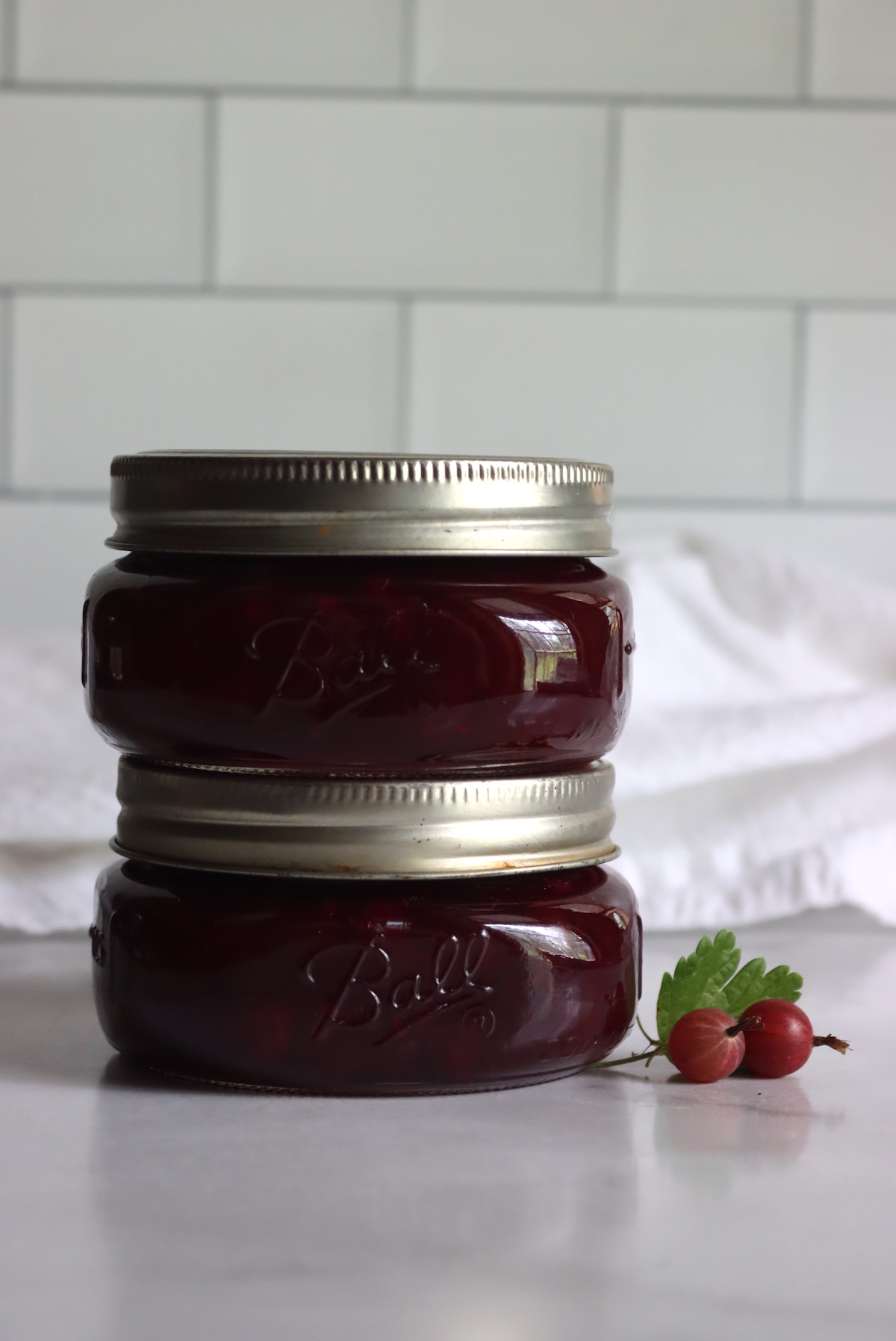
If you tried this Gooseberry Jam Recipe, or any other recipe on Creative Canning, leave a ⭐ star rating and let me know what you think in the 📝 comments below!
And make sure you stay in touch with me by following on social media!
Gooseberry Canning Recipes
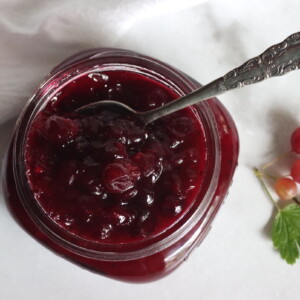
Gooseberry Jam
Equipment
Ingredients
- 3 cups gooseberries, roughly 1 lb
- ¼ cup water
- 2 cups sugar, about 1 lb
- 1-2 Tbsp lemon juice, optional
Instructions
- Clean the gooseberries by removing the tops and tails. This step may take some time, but it’s essential for the best results. The stems and flower ends of gooseberries remain tough when cooked, and they’ll ruin the texture of your finished jam if not removed.
- Place the cleaned gooseberries in a pot with a small amount of water and a splash of lemon juice if desired.
- Cook on medium-high heat, stirring often, until the berries disintegrate, approximately 5 minutes.
- Incorporate sugar into the pot. Gooseberries are quite tart, so adjust the sweetness as needed.
- Bring the mixture to a rapid boil and cook for 8 to 10 minutes until it reaches the gel stage (220 degrees F at sea level). You can check for set with an instant read thermometer or with a plate that’s been chilled in the freezer.
- Pour the finished jam into prepared jars, leaving ¼ inch of headspace.
- Store the jam in the fridge or process the jars in a water bath canner for 10 minutes (or 15 minutes if above 6,000 feet in elevation).
Notes
Lower Sugar Variation
This recipe requires at least 1 ½ cups of sugar to set without added boxed pectin, so you can reduce the sugar slightly, but not too much.Variations
Gooseberry jam is delicious on its own, but it also takes well to added flavors if you want to mix things up.- Gooseberry Gin Jam – Add ¼ cup of gin as the jam begins to thicken, just before it reaches the gel stage. Stir well and finish cooking as usual.
- Elderflower Gooseberry Jam – Add ¼ cup of elderflower cordial during the final few minutes of cooking for a delicate floral flavor.
- Gooseberry Rhubarb Jam – Add up to 2 cups of chopped rhubarb along with an extra ½ cup of sugar; the gooseberries will help the jam set naturally.
Nutrition
Nutrition information is automatically calculated, so should only be used as an approximation.
Old Fashioned Preserves
If you’re making gooseberry jam, chances are you’re already a fan of unique and old-fashioned preserves. Here are a few more creative canning recipes to try next:
- Gooseberry Jelly – A smooth preserve made by straining the juice from fresh gooseberries, perfect if you prefer a seedless spread.
- Blackcurrant Jam – Tart and flavorful, currants pair beautifully with gooseberries for a mixed jam or on their own as a classic preserve.
- Elderberry Jelly – Deeply colored and rich in antioxidants, this wild fruit jelly is a great addition to your canning pantry.
- Rhubarb Jam – Another tangy favorite, rhubarb makes a great partner for gooseberries or stands well on its own.
- Black Raspberry Jelly – Sweet, earthy, and richly flavored, this jelly is a summer classic with a short picking window.
Each of these preserves offers a unique twist on traditional fruit spreads—perfect for filling your pantry with variety and flavor.
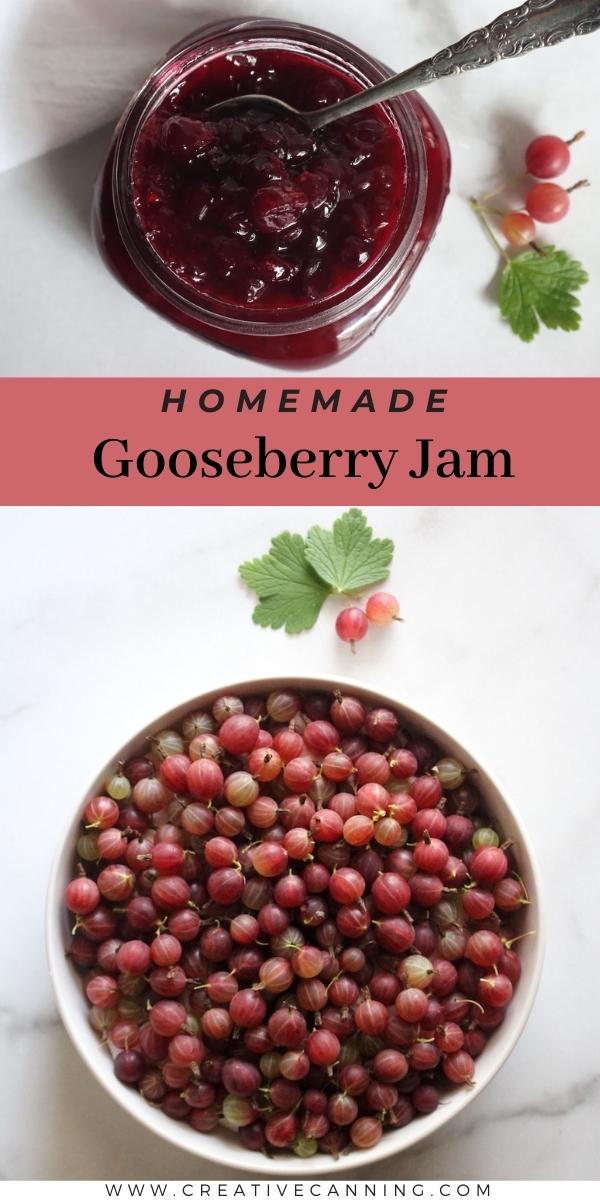
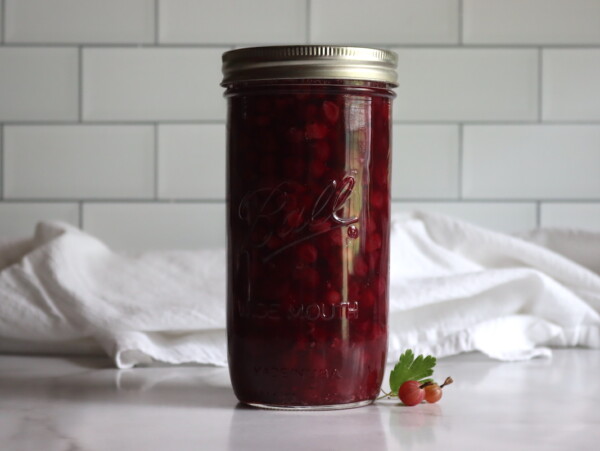
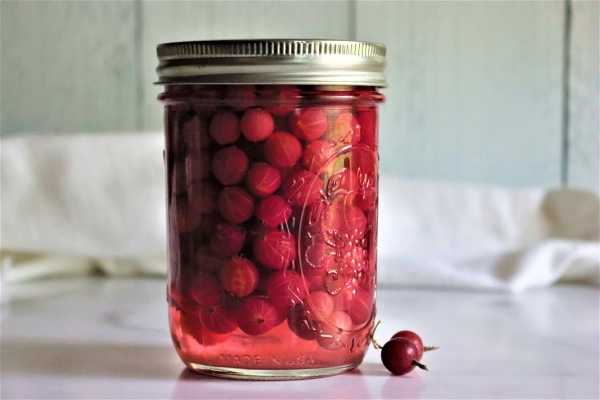
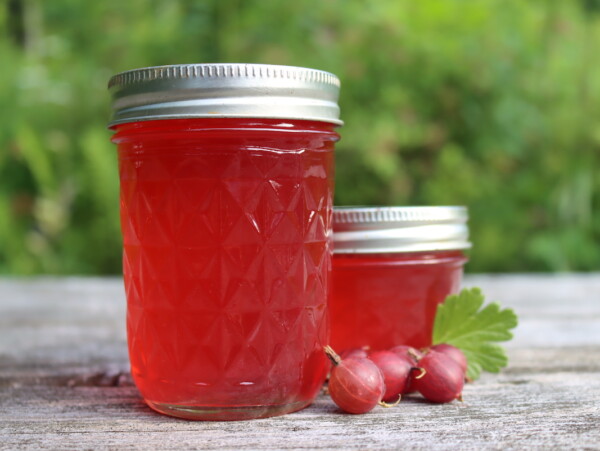
I love making jam that doesn’t need pectin. Easy to make and delicious.
So glad you liked it!